![Kobo Arc 10HD: A premium and pricey tablet that tries to please everyone [Review]](https://img-cdn.tnwcdn.com/image?fit=1280%2C720&url=https%3A%2F%2Fcdn0.tnwcdn.com%2Fwp-content%2Fblogs.dir%2F1%2Ffiles%2F2013%2F11%2FKoboFEat.jpg&signature=d1312dc763567bed064044d90b86e99a)
Kobo has been building out its ereader empire of late with a range of fairly impressive devices, such as the compact Kobo Aura, and its limited-edition Aura HD predecessor which launched back in April.
But what about tablets?
Well, just as Amazon did with the Kindle Fire/HD/HDX, and Barnes & Noble with the Nook Tablet and Nook HD/+, Kobo broadened its horizons last year with the launch of the Arc, a 7-inch HD tablet. If all the cool kids are doing it, why not join in?
Now, however, we’ve gotten our mitts on the Arc’s bigger brother – the recently-launched Arc 10HD. So we took it for a spin to see how this baby rolls.
But first…
The Specs
Make no mistake, Kobo’s latest tablet is a top-of-the-range device which is supported, in part, by its $399 price-tag. It sports a 10.1″, 2560×1600 HD+ display (300 ppi), with up to 1080p for video playback, and ships with Android 4.2.2 Jelly Bean.
In terms of overall size, the Arc 10HD comes in at 253 x 172 x 9.9 mm, and weighs 627 grams. It has 2GB of RAM, a quad-core processor (1.8 GHz), 16GB of storage (no micro SD), dual stereo speakers, a microphone and a 6550 mAh capacity battery. It also has a micro HDMI port.
It has a 1.3 MP (720p) front-facing HD camera only – so you won’t be able to use this for snapping pictures really (well, apart from selfies).
In terms of comparable devices, I guess the Nexus 10 is in the same ball-park, with a similar price, display, dimensions and memory, though Google’s incarnation has a 5 MP rear-facing camera too, and only weights 603g. It also only has a dual-core 1.7Ghz CPU, but it has a quad-core GPU. A new Nexus 10 is due out soon, but full details aren’t yet known about that.
It’s probably also worth mentioning the Kindle Fire HDX 8.9, even though it’s just that bit smaller than the Arc 10HD. At $394, Amazon’s latest Kindle-branded tablet has a similar display to Kobo’s, but its pixel density is 339 PPI. And at 334 grams, it is considerably lighter too, though admittedly part of that comes down to its smaller size. It also has a (quad-core) 2.2GHz processor, 2GB of RAM, and an 8 MP rear-facing camera.
What you get & how it looks
Inside the box all you’ll find is a micro USB cable, wall-charger and a small user-guide. But what more did you expect, caviar? Oh, right, yes – there’s also the Kobo tablet itself. Let’s not forget that.
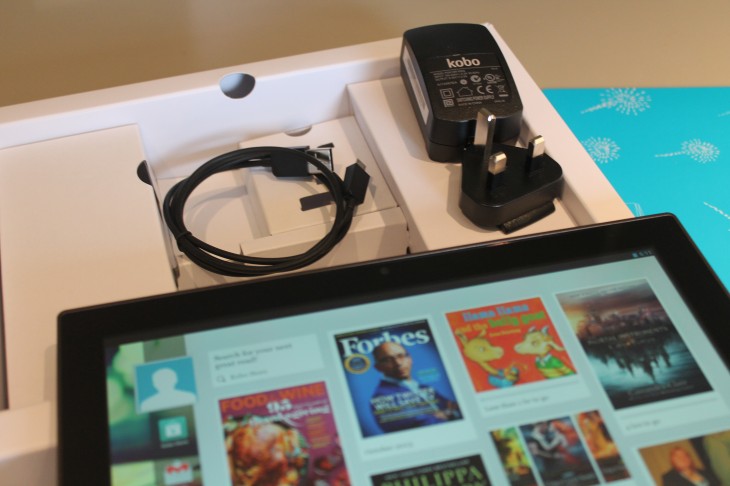
The first thing we noticed is that the tablet itself is very square – it has a sharper form (no need for gloves) than, say the Kindle Fire HDX, Nexus 10 or even Samsung’s range of Galaxy tablets. Check this side-by-side shot of Kobo’s (left) and Google’s (right) devices.
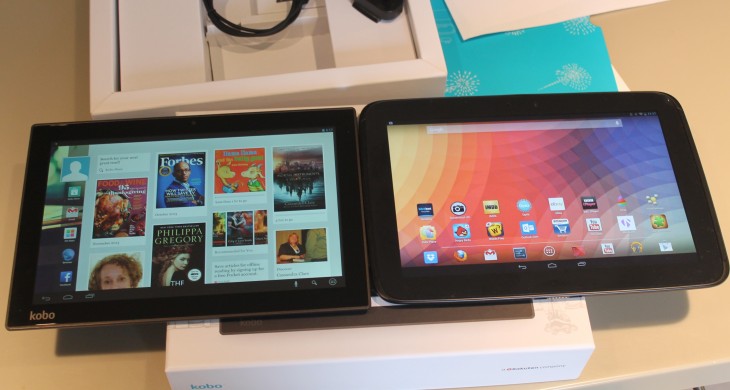
It’s a minor point, perhaps, but for the design-conscious, little matters such as this count in their overall buying decisions, and one isn’t necessarily better than the other. A closer inspection reveals just how pronounced the difference is.
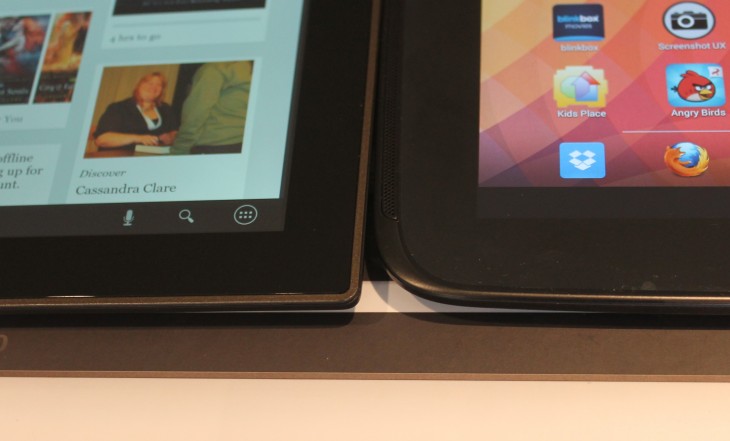
The Kobo’s two speakers feature at the top left/right on the back of the tablet, but when you flip the device around the first thing you’ll notice is the distinct slanted edges, sliding downwards from around one inch in.

The back of the Arc seems a little off-kilter, with slanting raised-lines pushing off in different directions along the edges, while the layout of the tiny holes that constitute the speakers aren’t identical on each side. This isn’t a bad thing, far from it – it definitely adds to the premium build, and makes it feel somewhat unique.
But you can only stare at the back for so long.
The front of the Kobo has edge-to-edge glass, which is an improvement on the plasticy bezel that circled the edge of the front on the original Arc last year.
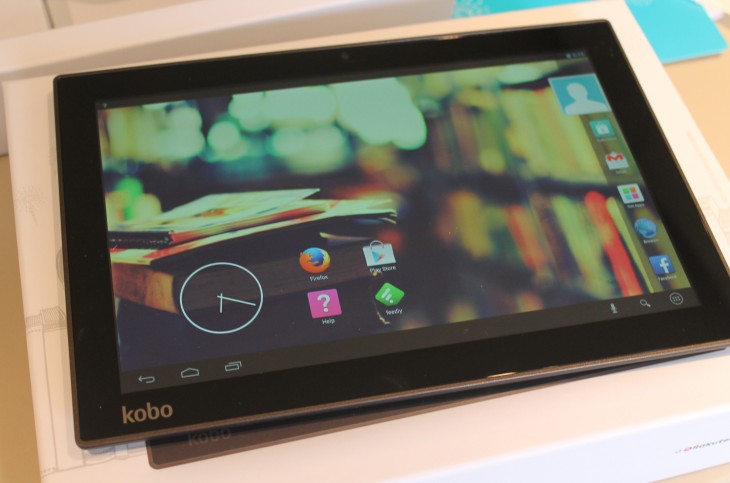
Under the hood
You slide a little red switch on the top-right edge of the tablet to power the device on and, well, you’re greeted by a fairly familiar Android layout. There’s Google Play and all the usual apps you’d expect, but remember the Kobo is designed as a tablet for those who like to read. So it does have some key customizations.
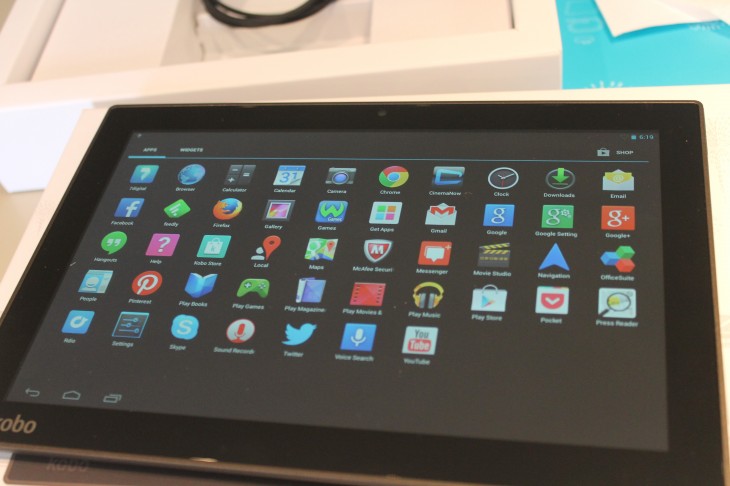
Swiping in from the left on the homescreen helps you gain access to Kobo’s Reading Life, delivering a dashboard that displays things like your recent reads, covering books, magazines and articles from Pocket (a partnership was announced back in August). You’ll also see recommendations based on your reading habits.

So yeah, Kobo has skinned Jelly Bean here, but it’s not all that bad. That said, the homepage featuring all your recommendations and what-not does feel a little cluttered, and could perhaps benefit from clearer sections – ‘Recent Reads’, ‘You Might Like’, ‘Pocket’ and so on. Everything kind of feels mashed in together.
Swipe again to the left, however, and you’ll be taken to your Collections, which displays all your content organized into individual categories. It automatically files your stuff into meaningful folders, such as ‘Magazines’, ‘Books’ and ‘Articles, but you can create your own custom ones too, so you could include ‘Education’, ‘Cooking’ and so on.
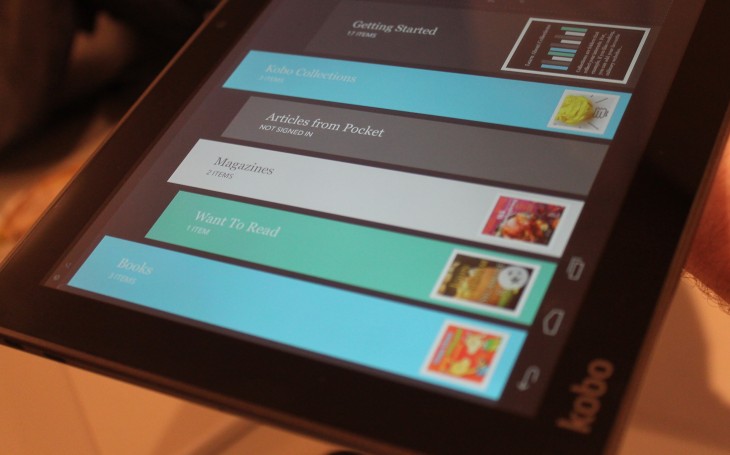
One other key factoid worth mentioning, one that reminds you this device is geared towards those with a love of reading, is ‘Reading Mode’.
How annoying is it when you’re trying to bust your way through War and Peace and you keep getting pinged with messages to play Words With Friends, or emails from work? Yes, this is what Reading Mode fixes. It’s like a souped up ‘Flight Mode’, offering granular controls for when it shuts off some, or all, the bells and whistles.
For example, you can set what time Read Mode is enabled automatically (e.g. evenings), or indicate that WiFi/Bluetooth is disabled as soon as you activate Reading Mode. You can also choose to hide notifications, mute sounds and alter the screen brightness.
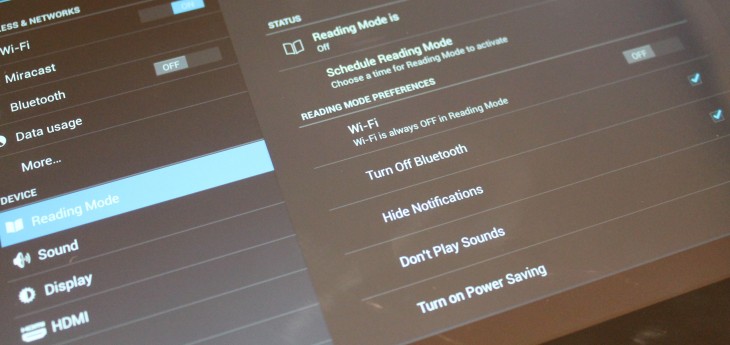
An ereader AND a tablet
Kobo is clearly trying to cater for two markets with the Arc – readers and Internet lovers. As such, the screen is pretty impressive (2560×1600 HD+ display, 300 ppi) – it was crystal clear and vibrant in our tests watching a couple of HD movies and reading magazines. It’s not an industry-beater by any means, but it’s certainly in the same ball park as the likes of the Kindle Fire HD.

As for the speakers, the sound wasn’t terribly great either. On full volume, the audio wasn’t that loud, so we’d recommend headphones or plug-in speakers here.
Battery
Kobo claims its 6550 mAh capacity battery will serve you with ‘up to’ 9.5 hours worth of juice, and we reckon it’s not a million miles from being right. Naturally, it depends on what you’re using it for, but with some reading, Web browsing and a little bit of video (15 minutes or so), we got to 50% battery remaining after around four hours.
But Reading Mode is Kobo’s attempt to make it easy to kill the distractions and help preserve some battery – with WiFi and Bluetooth off, and using this just as a reader, 9.5 hours sounds about right. But then, if all you want to use this for is reading, you’d may as well just buy a dedicated Kobo ereader, right?
For a tablet, the battery life seems so-so – not brilliant, but not awful either.
Verdict
Some folk would argue that ereaders are ereaders, and tablets are tablets – and never their paths should cross. Personally, I’d buy into that philosophy. The likes of the Kobo Aura and the Kindle Paperwhite are brilliant at replicating the book-reading experience – they’re light, compact, (relatively) cheap, last for ages on one charge and, ultimately, the text is easy on the eyes. Like a book.
That said, if you like magazines as much as you do books, then that’s one good reason to go for something like this – you get a full-color screen.
Then there’s the distraction element. The Kobo’s Reading Mode certainly goes some way towards tackling the attention span issue, but it’s still very easy to disable it and get your half-hourly email or Angry Birds fix – if you have the will power, this of course doesn’t matter. But it’s a matter worth considering nonetheless.
There’s no doubt that the Kobo Arc 10HD is a lovely piece of kit – it’s solid, has a distinct feel and a great screen. But there’s no getting away from the price – $400 is a lot of money for an Android tablet, especially when it could be a little lighter, could have a battery that promises a longer life and could have a rear-facing camera.
The Kobo Arc 10HD tries to keep everyone happy and with that, there’s always going to be compromises – for every ying, there’s a yang. But if you’re on the look-out for a new tablet AND ereader, and reckon you can put up with a shiny screen when wolfing down chapter-after-chapter of War and Peace, well, it could be money well spent.
Get the TNW newsletter
Get the most important tech news in your inbox each week.




